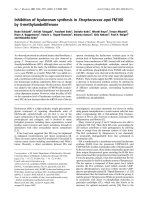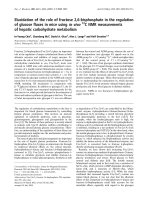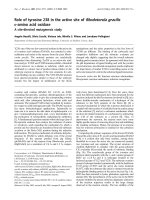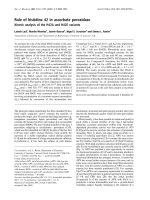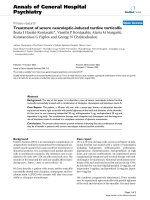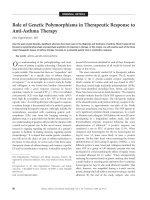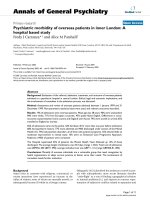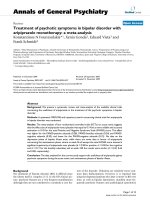Báo cáo y học: "Elucidation of the potential roles of matrix metalloproteinases in skeletal biology" pps
Bạn đang xem bản rút gọn của tài liệu. Xem và tải ngay bản đầy đủ của tài liệu tại đây (43.04 KB, 3 trang )
2
MMP = matrix metalloproteinase; PCR = polymerase chain reaction; r/r = collagenase-resistant homozygote.
Arthritis Research and Therapy Vol 5 No 1 Krane
Introduction
In a recent review in Arthritis Research, Murphy et al.
emphasized the importance of degradative processes in
joint tissue destruction in various forms of arthritis [1].
They presented aspects of the background biochemistry
of the matrix metalloproteinases (MMPs) as ‘major players’
in the physiological turnover of the extracellular matrix and
in the pathological destruction in disease. Specific
inhibitors were introduced as potential therapy for arthritis,
based on the potential roles of MMPs even though they
were directed at downstream events.
Despite phenomenal advances in this area, it is still neces-
sary to establish the importance of MMPs in processes
such as normal embryonic development and adult tissue
remodeling. This is essential to targeting a specific gene
product whose function is thought to be critical in patho-
logical events (e.g. degradation of bone and soft tissue
extracellular matrices), in disorders such as osteoarthritis
and rheumatoid arthritis. There are several approaches to
establish that a MMP has the postulated biological func-
tion in arthritis. It is not sufficient only to demonstrate the
presence of the MMP in tissue extracts or by immunohis-
tochemistry in tissue sections, or to find elevated levels of
mRNA in extracted RNA by northern hybridization, by
quantitative PCR or by in situ hybridization in tissue sec-
tions. The identification in affected tissues of the specific
cleavage product of a MMP-catalyzed reaction provides
better evidence for an in vivo function. For example, using
antibodies directed against the collagenase cleavage site
in collagens, positive staining has been found for cleavage
products of type I collagen in bone and of type II collagen
in cartilage [2,3]. The expected effect of a specific enzyme
inhibitor drug supports the role of the enzyme, although in
the case of MMP inhibitors the specificity in vivo is yet to
be established [4]. The demonstration of the expected
phenotype that results from a spontaneous mutation in a
MMP gene in humans or animals or from the targeted
manipulation of a MMP gene in mice would provide the
most compelling evidence.
The report of the mutation in the gene encoding MMP-2
(gelatinase A or 72 kDa gelatinase) in a human skeletal
disorder is therefore of great interest [5,6]. There are
several forms of osteolysis in humans that have a genetic
basis. For example, a focal form (familial expansile osteoly-
sis that maps to chromosome 18q21.2-21.3) appears to
be explained by a mutation in the receptor activator of
Irreversible destruction of joint structures is a major feature of osteoarthritis and rheumatoid arthritis.
Fibrillar collagens in bone, cartilage and other soft tissues are critical for optimal joint form and
function. Several approaches can be used to ascertain the role of collagenases, matrix
metalloproteinases, in proteolysis of joint collagens in arthritis. These approaches include identifying
spontaneous genetic disorders of the enzymes and substrates in humans and animals, as well as
engineering mutations in the genes that encode these proteins in mice. Insights gained from such
studies can be used to design new therapies to interrupt these catabolic events.
Keywords: arthritis, bone remodeling, collagenases, collagens, skeletal development
Commentary
Elucidation of the potential roles of matrix metalloproteinases in
skeletal biology
Stephen M Krane
Department of Medicine, Harvard Medical School, Center for Immunology and Inflammatory Diseases, Massachusetts General Hospital,
Charlestown, Massachusetts, USA
Corresponding author: Stephen M Krane (e-mail: )
Received: 4 September 2002 Accepted: 6 September 2002 Published: 8 October 2002
Arthritis Res Ther 2003, 5:2-4 (DOI 10.1186/ar600)
© 2003 BioMed Central Ltd (
Print ISSN 1478-6354; Online ISSN 1478-6362)
Abstract
3
Available online />nuclear factor-κB gene that encodes constitutive activa-
tion and excessive osteoclastic bone resorption [7]. In a
more generalized disorder of osteolysis, Whyte et al.
recently identified the homozygous deletion of the gene on
chromosome 8q24.2, TNFRSF11B, that encodes osteo-
protegerin, a ‘bone protector’ [8].
More pertinent to the MMP field, Martignetti and col-
leagues described a form of multicentric osteolysis with
tarsal and carpal bone resorption, accompanied by severe
arthritis, osteoporosis, subcutaneous nodules and a dis-
tinctive facies, in several members of large, consan-
guineous Saudi Arabian families [5,6]. They localized the
gene to 16q12-21 and demonstrated two family-specific
mutations in the gene in the region that encodes MMP-2.
In one family, there was a nonsense mutation that pre-
dicted the replacement of a tyrosine by a stop codon
(Y244X). In another family, there was a missense mutation
that predicted the substitution of an arginine by a histidine
(R101H). In affected members of both families there was
no MMP-2 activity detected in serum by gelatin zymogra-
phy, in contrast to measurable levels in unaffected
members. Although it is clear that affected individuals with
this syndrome have decreased function of MMP-2, the
clinical phenotype is not yet explained.
We still do not know precisely what role MMP-2 plays in
human biological processes. In vitro MMP-2 can cleave
type I and type IV collagens, but it is not known whether
these are substrates for MMP-2 in vivo. In this regard, it
should be appreciated that most of the MMPs were
named after they were shown to act on a particular protein
substrate in vitro, but such proteolysis may not be the bio-
logical function of the enzyme. Indeed, the null mutation in
MMP-2 engineered in mice results in a very mild pheno-
type, manifested mainly by a decrease in bone length [9].
It has been speculated [10] that the function of MMP-2
might overlap with that of MMP-14 (MT1-MMP, a mem-
brane-bound MMP); the engineered loss-of-function muta-
tion of MMP-14 [11,12] is associated with skeletal
defects considered to partially resemble those of the
patients with the multicentric osteolysis syndrome. Most
MMP-14
–/–
mice die when they are only a few weeks of
age, however, and the pathogenesis and nature of the
abnormalities in bone and cartilage in the mice that survive
is not yet clearly established. Whatever the mechanisms
to account for the abnormalities, the observations in multi-
centric osteolysis are important for the field since they
comprise the first demonstration of a spontaneous muta-
tion in a MMP gene resulting in a human disease. We look
forward to descriptions of mutations and the resultant
phenotype in other MMP genes.
Our group has also taken advantage of mouse models to
further explore potential roles of MMPs in vivo. The first of
these models is the collagenase-resistant (r) mouse, tar-
geting mutations in Col1a1 that encode amino acid sub-
stitutions around the collagenase cleavage site in the α1(I)
chain of type I collagen [13–15]. The type I collagen
extracted from the skin and tendons of homozygote (r/r)
mice is not cleaved in the helical domain by MMP-13 or
other collagenolytic MMPs. The r/r mice do not mount a
normal osteoclast-mediated bone-resorptive response to
parathyroid hormone, an inducer of bone resorption in vivo
[16]. It had been hypothesized, based on published
studies of osteoclast attachment and pit formation in in
vitro assays, that collagenase produced by osteoblasts in
remodeling bone acts on a layer of hypomineralized colla-
gen on bone surfaces to permit osteoclasts to attach
[17,18] and then resorb in the low-pH extracellular envi-
ronment through action of the cysteine proteinase, cathep-
sin K [19]. There are other possible explanations, however,
for the defect in bone resorption in the r/r mice, including
a role for collagenase in osteoclast survival. The r/r mice
also develop increased new bone, paradoxically in the
presence of osteoblast and osteocyte apoptosis [20].
The second mouse model developed in our laboratory,
descriptions of which have so far only appeared as
abstracts [21,22], is the targeted disruption of the MMP-
13 gene. The strategy employed involved the deletion of
the critical zinc-binding region in the catalytic domain that
resulted in markedly decreased transcription of the MMP-
13 gene and no apparent translation. Recombinant MMP-
13 lacking this catalytic domain has no enzymatic activity.
The MMP-13
–/–
mice are fertile, and they grow and survive
normally. The major developmental phenotype includes
widened growth plates of long bones with increased
chondrocyte proliferation and thickness of the hyper-
trophic zones. There are also striking alterations in bone
remodeling seen as the mice mature. Bone resorption is
reduced due to disordered osteoclast function, and bone
deposition is increased ascribable to increased generation
of osteoblasts.
Conclusion
MMP-13 has critical roles in embryonic development and
remodeling of the skeleton in mice. These roles are
reflected in the collagenase-mediated destruction of bone
and cartilage in several forms of human inflammatory joint
disease. Understanding precisely how MMP-13 functions
will permit design of different approaches to dealing with
these vents in arthritis.
Acknowledgement
The original work described here was supported by Grants from the
National Institutes of Health (AR-03564, AR-07258, AR-44815).
References
1. Murphy G, Knauper V, Atkinson S, Butler G, English W, Hutton M,
Stracke J, Clark I: Matrix metalloproteinases in arthritic
disease. Arthritis Res 2002, 4(suppl 3):S39-S49.
2. Otterness IG, Downs JT, Lane C, Bliven ML, Stukenbrok H, Scam-
poli DN, Milici AJ, Mezes PS: Detection of collagenase-induced
4
Arthritis Research and Therapy Vol 5 No 1 Krane
damage of collagen by 9A4, a monoclonal C-terminal neo-
epitope antibody. Matrix Biol 1999, 18:331-341.
3. Hellio Le Graverand MP, Eggerer J, Sciore P, Reno C, Vignon E,
Otterness I, Hart DA: Matrix metalloproteinase-13 expression
in rabbit knee joint connective tissues: influence of matura-
tion and response to injury. Matrix Biol 2000, 19:431-441.
4. Coussens LM, Fingleton B, Matrisian LM: Matrix metallopro-
teinase inhibitors and cancer: trials and tribulations. Science
2002, 295:2387-2392.
5. Al Aqeel A, Al Sewairi W, Edress B, Gorlin RJ, Desnick RJ, Mar-
tignetti JA: Inherited multicentric osteolysis with arthritis: a
variant resembling Torg syndrome in a Saudi family. Am J
Med Genet 2000, 93:11-18.
6. Martignetti JA, Aqeel AA, Sewairi WA, Boumah CE, Kambouris M,
Mayouf SA, Sheth KV, Eid WA, Dowling O, Harris J, Glucksman
MJ, Bahabri S, Meyer BF, Desnick RJ: Mutation of the matrix
metalloproteinase 2 gene (MMP2) causes a multicentric oste-
olysis and arthritis syndrome. Nat Genet 2001, 28:261-265.
7. Hughes AE, Ralston SH, Marken J, Bell C, MacPherson H,
Wallace RG, van Hul W, Whyte MP, Nakatsuka K, Hovy L, Ander-
son DM: Mutations in TNFRSF11A, affecting the signal peptide
of RANK, cause familial expansile osteolysis. Nat Genet 2000,
24:45-48.
8. Whyte MP, Obrecht SE, Finnegan PM, Jones JL, Podgornik MN,
McAlister WH, Mumm S: Osteoprotegerin deficiency and juve-
nile Paget’s disease. N Engl J Med 2002, 347:175-184.
9. Itoh T, Ikeda T, Gomi H, Nakao S, Suzuki T, Itohara S: Unaltered
secretion of beta-amyloid precursor protein in gelatinase A
(matrix metalloproteinase 2)-deficient mice. J Biol Chem
1997, 272:22389-22392.
10. Vu TH: Don’t mess with the matrix. Nat Genet 2001, 28:202-203.
11. Holmbeck K, Bianco P, Caterina J, Yamada S, Kromer M,
Kuznetsov SA, Mankani M, Robey PG, Poole AR, Pidoux I, Ward
JM, Birkedal-Hansen H: MT1-MMP-deficient mice develop
dwarfism, osteopenia, arthritis, and connective tissue disease
due to inadequate collagen turnover. Cell 1999, 99:81-92.
12. Zhou Z, Apte SS, Soininen R, Cao R, Baaklini GY, Rauser RW,
Wang J, Cao Y, Tryggvason K: Impaired endochondral ossifica-
tion and angiogenesis in mice deficient in membrane-type
matrix metalloproteinase I. Proc Natl Acad Sci USA 2000, 97:
4052-4057.
13. Wu H, Byrne MH, Stacey A, Goldring MB, Birkhead JR, Jaenisch
R, Krane SM: Generation of collagenase-resistant collagen by
site-directed mutagenesis of murine pro
αα
1(I) collagen gene.
Proc Natl Acad Sci USA 1990, 87:5888-5892.
14. Liu X, Wu H, Byrne M, Jeffrey J, Krane S, Jaenisch R: A targeted
mutation at the known collagenase cleavage site in mouse
type I collagen impairs tissue remodeling. J Cell Biol 1995,
130:227-237.
15. Krane SM, Byrne MH, Lemaître V, Henriet P, Jeffrey JJ, Witter JP,
Liu X, Wu H, Jaenisch R, Eeckhout Y: Different collagenase
gene products have different roles in degradation of type I
collagen. J Biol Chem 1996, 271:28509-28515.
16. Zhao W, Byrne MH, Boyce BF, Krane SM: Bone resorption
induced by parathyroid hormone is strikingly diminished in
collagenase-resistant mutant mice. J Clin Invest 1999, 103:
517-524.
17. Chambers TJ, Darby JA, Fuller K: Mammalian collagenase pre-
disposes bone surfaces to osteoclastic resorption. Cell Tissue
Res 1985, 241:671-675.
18. Holliday LS, Welgus HG, Fliszar CJ, Veith GM, Jeffrey JJ, Gluck
SL: Initiation of osteoclast bone resorption by interstitial colla-
genase. J Biol Chem 1997, 272:22053-22058.
19. Saftig P, Hunziker E, Everts V, Jones S, Boyde A, Wehmeyer O,
Suter A, von Figura K: Functions of cathepsin K in bone resorp-
tion. Lessons from cathepsin K deficient mice. Adv Exp Med
Biol 2000, 477:293-303.
20. Zhao W, Byrne MH, Wang Y, Krane SM: Inability of collagenase
to cleave type I collagen in vivo is associated with osteocyte
and osteoblast apoptosis and excessive bone deposition.
J Clin Invest 2000, 106:941-949.
21. Wang Y, Byrne MH, Inada M, Rahman MU, Krane SM: Null muta-
tion in collagenase-3 (matrix metalloproteinase [MMP]-13)
affects maturation of growth plates [abstract]. J Bone Mineral
Res 2001, 16(suppl 1):S141.
22. Inada M, Wang Y, Byrne MH, Miyaura C, Krane SM: Mice with
null mutation in collagenase-3 (matrix metalloproteinase
[MMP]-13) exhibit altered bone remodeling and increased
bone mass [abstract]. J Bone Mineral Res 2001, 16(suppl 1):
S149.
Correspondence
Stephen M Krane, Department of Medicine, Harvard Medical School,
Center for Immunology and Inflammatory Diseases (CIID), Room 8301,
Massachusetts General Hospital, Building 149, 13th Street,
Charlestown, MA 02129, USA. Tel: +1 617 726 5650; fax: +1 617
726 5651; e-mail:

